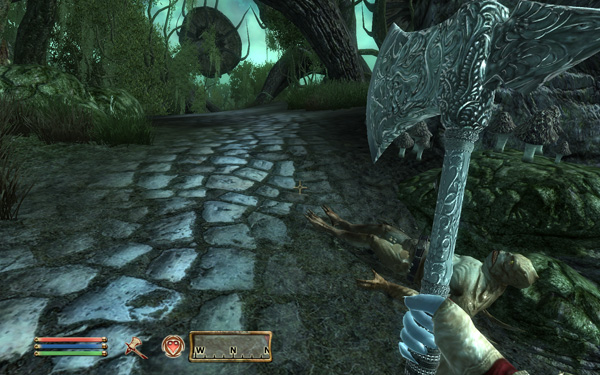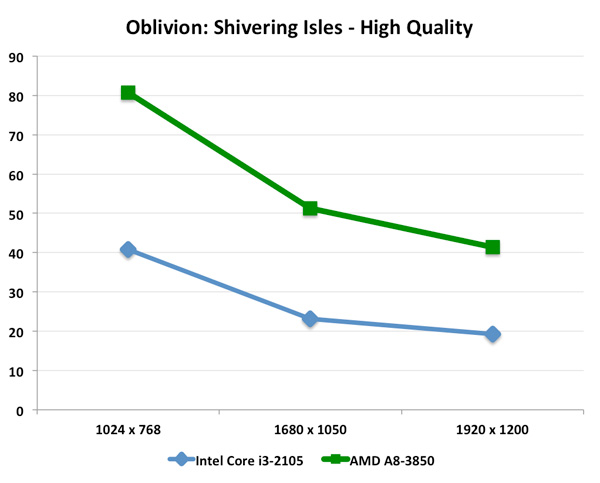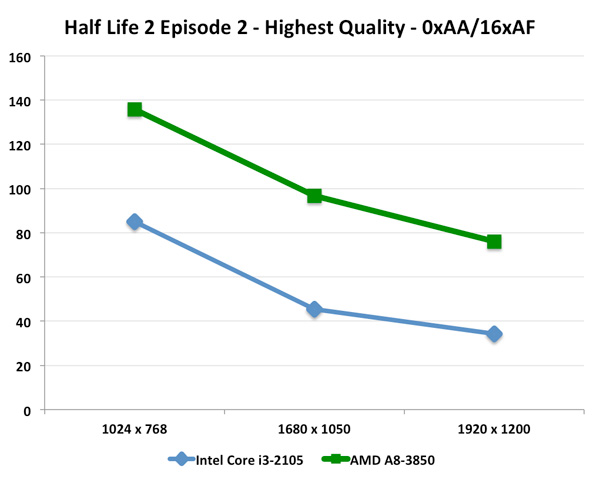The AMD A8-3850 Review: Llano on the Desktop
by Anand Lal Shimpi on June 30, 2011 3:11 AM ESTPerformance in Older Games
In response to our preview a number of you asked for performance in older titles. We dusted off a couple of our benchmarks from a few years ago to see how Intel's HD 3000 and AMD's Radeon HD 6550D handled these golden oldies.

First up is a personal favorite: Oblivion. Our test remains unchanged from when we used to run this test, the only difference is we're actually able to get playable frame rates from integrated graphics now. We set the game to High Quality defaults, although the Intel platform had to disable HDR in order to get the game to render properly:

The Core i3-2105 with its HD Graphics 3000 can actually deliver a playable experience at 1024 x 768 with just over 40 fps. Move to higher resolutions however and you either have to drop quality settings or sacrifice playability. The A8-3850 gives you no such tradeoff. Even at 1920 x 1200 the A8 manages to deliver over 40 fps using Oblivion's High Quality defaults.
We saw similar results under Half Life 2: Episode Two:

Here the Core i3 maintains playability all the way up to 1920 x 1200, but you obviously get much higher frame rates from the Llano APU.










99 Comments
View All Comments
mino - Sunday, July 3, 2011 - link
Tell ya what. The benefit is we get paid trolls like you over here.jaydee - Thursday, June 30, 2011 - link
How many monitors can you connect to this with a discrete gpu? Can you do 3 or more DVI/HDMI montors between the motherboard output and a discrete gpu?j_iggga - Thursday, June 30, 2011 - link
The other dude hit it on the mark. The target for this is OEM parts for budget desktops. So the point about the discrete GPU being more cost effective is mootSo given that...it's great that finally everyone can game adequately.
1920 x 1080 on integrated? unheard of in my time
HangFire - Thursday, June 30, 2011 - link
OK, so maybe it's better than i3 for laptops. But what I was looking for in Llano was a greatly improved per-clock efficiency in the CPU, something that will drag AMD back into true competitiveness with Intel.Instead we get slight tweaking.
If Bulldozer doesn't deliver a better CPU than oft-tweaked cores dating back to Hammer, AMD is dead on the desktop. Low-end laptops will be the only place they can compete, at least until Intel completes implementing DirectX 10 and 11.
L. - Thursday, June 30, 2011 - link
Bulldozer will deliver .. and it will kill Intel at it's price point, I bet your head on that ;)And Intel will be dead on the Server market, you can expect a 30+% perf/watt advantage for Interlagos on release day, only dampened when Intel will release their first 22nm Xeon ---
More blood in the water, better market for us.
BSMonitor - Thursday, June 30, 2011 - link
Bet taken. Bulldozer will be an underclocked, overheating monster. AMD is 2 years minimum behind with Bulldozer.Ivy Bridge will be out before Bulldozer... Bet on that.
L. - Thursday, June 30, 2011 - link
AMD is 2 years in advance with bulldozer, as it is not designed as a desktop processor, but a byproduct of Interlagos, which will very likely take a lot of server market share from Intel.I'd like to see how AMD could be two years behind, when Intel has been stretching a core design from core1 to sandy bridge ;)
Bet on the fact that AMD has always priced their stuff right, Bulldozer is in i7-2600k range, that means it will beat it hands down.
Ivy will be a win in desktop for Intel, but then again, this depends on how fast both Intel and GF can get to 3d-gate 22nm. (which if we look at current trends would mean Intel 6 months before GF more or less).
BSMonitor - Thursday, June 30, 2011 - link
You are completely wrong. Bulldozer was scheduled for release in 2009. It is 2011. Hence 2 years.Considering Conroe processors still dominate Phenom II x2, x4, and x6 processors from AMD. I would say AMD is behind. About 3 generations.
GF is just now shipping its first 32nm chips. Still not a single heavyweight chip at 32nm. Intel has 32nm 6-core processors for over a year. Ivy Bridge is out this fall at 22nm.
Are you just completely drinking the AMD Kool-Aide or what?
silverblue - Thursday, June 30, 2011 - link
If I remember correctly, Bulldozer's design was torn up and started again from scratch in 2008. This would undoubtedly increase development time, especially if they completely changed the design.And for the final time, stop spreading BS about Conroe dominating Phenom II. Even Penryn doesn't. There are plenty of instances where K10.5 beats the Core 2 family and in most cases where Core 2 wins, the difference is marginal at best, not to mention that a) there aren't any hexacore Core 2s out there nor any with any turbo technology, and b) any sufficiently high performing Core 2 parts are massively more expensive than anything AMD is shipping.
I dedicated a HUGE post on this topic to you on Toms using Anandtech Bench data and you've obviously decided to ignore it so... believe what you like. :)
BSMonitor - Thursday, June 30, 2011 - link
Yeah, I exaggerated. But the only way to deal with the diluted is to use such devices. Perhaps they will think and research.Phenom II vs Core 2 is not even close clock for clock.
Phenom II only wins in scenarios where it is grossly clocked higher than the similar Core 2. The 9650 is a 3GHz part, Ph II 980 a 3.7GHz part.
http://www.anandtech.com/bench/Product/49?vs=362
The recently released 980 barely outperforms the 3 y/o Penryn Core 2.